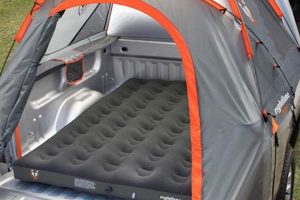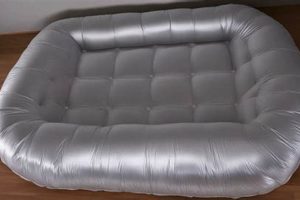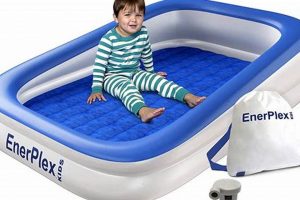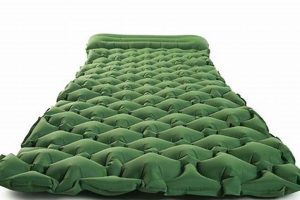An air mattress equipped with an integrated inflation system provides a convenient method for achieving desired firmness levels without the need for external devices. These mattresses feature a self-contained mechanism, typically electric, designed to introduce air into the mattress chamber, achieving a comfortable sleeping surface. The process usually involves connecting the mattress to a power source and activating the embedded pump.
The primary advantage of using an inflatable mattress with an integrated pump lies in its ease of use and portability. The self-contained design eliminates the need to transport and store separate pumps, simplifying the setup and takedown process. This feature is particularly beneficial for camping, guest accommodations, and temporary sleeping arrangements, where minimizing equipment and maximizing efficiency are priorities.
The subsequent sections detail the necessary steps for effective inflation, potential troubleshooting tips, and preventative measures to ensure the longevity of an air mattress with an integrated inflation system. Proper execution of these steps will contribute to optimal user experience and product lifespan.
Tips for Efficient Inflation
Optimizing the inflation process for an air mattress with an integrated pump ensures proper functionality and extends the lifespan of the product. Adhering to these guidelines facilitates effective and trouble-free operation.
Tip 1: Ensure Proper Power Connection: Verify that the power cord is securely connected to both the mattress and a functioning power outlet. A loose connection can result in incomplete inflation or damage to the integrated pump mechanism.
Tip 2: Consult the Instruction Manual: Prior to initial use, refer to the manufacturer’s instruction manual for specific inflation guidelines. Different models may have varying recommended inflation times and pressure levels.
Tip 3: Monitor Inflation Time: Avoid over-inflation. Continuously monitor the mattress during the inflation process and cease operation of the integrated pump once the desired firmness is achieved. Over-inflation can lead to seam stress and potential rupture.
Tip 4: Protect the Mattress Surface: Before initiating inflation, ensure the mattress is placed on a smooth, debris-free surface. Sharp objects or rough textures can puncture the mattress during the inflation process.
Tip 5: Utilize Designated Inflation Valve: Only use the inflation valve specifically designed for use with the integrated pump. Attempting to inflate the mattress through alternative valves can damage the internal components.
Tip 6: Regular Inspection for Leaks: Periodically inspect the mattress for potential leaks, especially along seams and around the valve. Addressing minor leaks promptly can prevent further damage and maintain optimal inflation.
Tip 7: Store in a Climate-Controlled Environment: When not in use, store the air mattress in a climate-controlled environment away from extreme temperatures and direct sunlight. These conditions can degrade the material and compromise the effectiveness of the integrated pump.
Implementing these tips contributes to a more efficient and reliable inflation experience, ultimately prolonging the functionality and lifespan of the inflatable mattress.
The following section addresses common troubleshooting scenarios encountered when using air mattresses with integrated inflation systems.
1. Power Source Verification
The functionality of an air mattress with an integrated pump is fundamentally dependent on a reliable power source. Without sufficient and consistent electrical input, the integrated pump cannot operate effectively, thereby rendering the inflation process incomplete or impossible. The connection between power source verification and the successful inflation of such a mattress is a direct causal relationship: inadequate power equals inadequate or non-existent inflation.
The importance of verifying the power source manifests in several practical scenarios. Consider a camping situation where the electrical generator is malfunctioning, providing intermittent power. Attempts to inflate the mattress under these conditions will likely result in a partially inflated mattress, offering inadequate support and comfort. Similarly, in a household setting, a damaged extension cord or faulty outlet may prevent the pump from reaching its operational capacity, leading to the same outcome. These examples underscore the necessity of confirming that the power supply is both stable and sufficient to meet the pump’s power requirements, as specified by the manufacturer.
In summation, power source verification is not merely a preliminary step; it is an indispensable prerequisite for the successful inflation of an air mattress with an integrated pump. Overlooking this aspect can lead to significant inconvenience and negate the intended benefits of the integrated pump design. Ensuring a stable and adequate power supply is paramount for realizing the full potential of this type of mattress.
2. Valve Integrity Assessment
Valve integrity assessment is a critical component in the successful deployment and sustained use of air mattresses with integrated inflation systems. The valve assembly serves as the primary interface for air entry and retention; any compromise to its structure or functionality directly impacts the mattress’s ability to maintain its inflated state.
- Sealing Surface Evaluation
The sealing surface of the valve, where the cap or integrated pump nozzle makes contact, must be free of debris, cracks, or irregularities. A compromised sealing surface will prevent an airtight closure, resulting in gradual air leakage and a loss of firmness. For instance, minute particulate matter trapped on the sealing surface can create channels for air to escape, necessitating frequent reinflation.
- Valve Core Functionality
Certain air mattress valves incorporate a core mechanism similar to those found in pneumatic tires. This core must be properly seated and free from obstruction to allow unidirectional airflow during inflation and prevent backflow when the pump is deactivated. A malfunctioning valve core can impede the inflation process or result in rapid deflation upon removal of the pump nozzle.
- Valve Housing Structural Integrity
The valve housing, typically constructed from plastic or a similar durable material, must be structurally sound to withstand the pressure exerted during inflation and deflation cycles. Cracks or fractures in the housing can compromise its ability to maintain an airtight seal, leading to air leakage. Exposure to extreme temperatures or physical
stress can accelerate the degradation of the valve housing material. - Compatibility with Integrated Pump
It is crucial to verify compatibility between the air mattress valve and the integrated pump nozzle. Mismatched or poorly fitting components may not establish a secure connection, leading to inefficient inflation and potential damage to the valve or pump. Using only the components designed specifically for the mattress is vital for maintaining optimal function.
In summation, the valve integrity assessment is an essential procedure in ensuring the effectiveness of an air mattress with an integrated pump. By systematically evaluating the sealing surface, valve core, housing structure, and compatibility with the pump, users can mitigate the risk of air leakage and maximize the lifespan and performance of the inflatable mattress. Regular inspection and proper maintenance of the valve assembly contribute directly to a reliable and comfortable sleeping experience.
3. Inflation Duration Monitoring
Inflation duration monitoring is a critical aspect of employing air mattresses equipped with integrated pumps. A direct correlation exists between the time the pump operates and the resulting air pressure within the mattress. Improper monitoring can lead to two adverse outcomes: under-inflation, resulting in inadequate support and comfort, or over-inflation, potentially causing seam stress and subsequent mattress failure.
The significance of inflation duration monitoring becomes evident when considering the varying capacities and power outputs of integrated pumps across different air mattress models. A low-power pump may require a longer operating time to achieve the desired firmness compared to a high-power pump. Overlooking this difference and adhering to a fixed inflation time, irrespective of the pump’s specifications, increases the risk of either under- or over-inflation. Furthermore, ambient temperature and initial mattress temperature can affect the air pressure within the mattress, requiring adjustments to the inflation duration. For example, inflating a mattress in a cold environment may necessitate a slightly longer inflation time due to the lower air density.
Effective inflation duration monitoring requires careful observation of the mattress’s firmness and adherence to the manufacturer’s guidelines. Regular assessment of the mattress during inflation, rather than relying solely on pre-set timers, is advisable. Ultimately, mastering inflation duration monitoring ensures optimal comfort, extends the lifespan of the air mattress, and maximizes the utility of the integrated pump.
4. Surface Area Preparation
Surface area preparation is a prerequisite for the successful inflation of an air mattress equipped with an integrated pump. The condition of the underlying surface directly impacts the structural integrity of the mattress and the overall efficiency of the inflation process. Neglecting this preparatory step can lead to damage, reduced lifespan, and compromised user comfort.
- Debris Removal
The presence of particulate matter, such as small stones, twigs, or sharp objects, poses a significant risk to the air mattress. These objects can puncture the material during inflation, creating leaks and rendering the mattress unusable. Thoroughly sweeping or vacuuming the area before placing the mattress minimizes the likelihood of such damage. For instance, failing to remove a small pebble on a campsite could result in a slow leak that gradually deflates the mattress throughout the night.
- Surface Leveling
An uneven surface can distribute weight unevenly across the mattress, placing undue stress on specific seams and potentially causing them to fail. Leveling the surface, either by relocating to a flatter area or using a leveling material, ensures that the mattress is supported uniformly. Inadequate leveling can lead to localized stretching of the mattress material and premature wear, particularly in areas that bear a disproportionate amount of weight.
- Protective Barrier Implementation
The use of a protective barrier, such as a groundsheet or tarp, between the air mattress and the underlying surface provides an additional layer of defense against abrasions and punctures. This barrier also protects the mattress from moisture and dirt, which can degrade the material over time. A thin layer of water accumulating under the mattress, for example, can promote the growth of mold and mildew, compromising the structural integrity of the mattress and creating an unsanitary sleeping environment.
- Weight Distribution Considerations
Analyzing the potential weight distribution across the surface area is a crucial aspect. Avoiding placement of the mattress on surfaces with concentrated points of pressure from furniture legs or protruding objects is important. Such pressure points, even if initially unnoticed, can lead to material fatigue and eventual rupture. This consideration is particularly relevant when using air mattresses in indoor environments with existing furniture layouts.
In conclusion, adequate surface area preparation is integral to maximizing the performance and longevity of an air mattress with an integrated pump. By meticulously addressing debris removal, surface leveling, protective barrier implementation, and weight distribution, the risk of damage is minimized, ensuring a more comfortable and durable sleeping solution. This proactive approach safeguards the investment and enhances the user experience.
5. Firmness Level Determination
Firmness level determination is intrinsically linked to the operational procedure of an air mattress equipped with an integrated pump. This determination dictates the duration for which the integrated pump is activated, directly influencing the internal air pressure and, consequently, the support offered by the mattress. An informed assessment of the desired firmness is therefore essential for optimal utilization of the inflation system.
The relationship between firmness level determination and the inflation process is not arbitrary. For instance, an individual with a preference for a firm sleeping surface will necessitate a longer inflation duration, resulting in higher internal pressure, compared to someone favoring a softer feel. Incorrectly assessing the desired firmness can lead to discomfort and inadequate spinal support. Consider the scenario of a side sleeper who prefers a softer mattress to allow for shoulder and hip contouring. Over-inflation, stemming from a misjudgment of the required firmness, would create a rigid surface, exacerbating pressure points and disrupting sleep. Conversely, under-inflation for a back sleeper requiring lumbar support would fail to provide adequate spinal alignment, potentially leading to back pain.
In conclusion, accurate firmness level determination is a critical prerequisite for the effective operation of an air mattress with an integrated pump. The inflation process must be guided by a precise understanding of the desired level of support and comfort. Achieving this necess
itates careful consideration of individual sleeping preferences and potential health considerations, ensuring that the utilization of the integrated pump results in a customized and supportive sleep experience.
6. Storage Environment Consideration
The storage environment exerts a significant influence on the subsequent inflation and overall functionality of an air mattress equipped with an integrated pump. The conditions under which the mattress is stored directly affect the material integrity, pump efficiency, and the likelihood of successful inflation when needed.
- Temperature Fluctuations
Extreme temperature variations, encompassing both high heat and freezing conditions, can degrade the polymers comprising the mattress material. Repeated expansion and contraction due to temperature changes can lead to cracking, weakening of seams, and compromised air retention. Storing the mattress in an uninsulated attic or garage, where temperatures fluctuate drastically, exemplifies a high-risk scenario. Such degradation may not be immediately apparent but will manifest as increased air leakage and reduced overall lifespan, impacting the ability to inflate the mattress to its intended capacity.
- Humidity Levels
Elevated humidity promotes the growth of mold and mildew, particularly within the mattress’s internal chambers and around the integrated pump components. These organisms can compromise the material, leading to unpleasant odors and potentially causing allergic reactions. Furthermore, moisture can corrode electrical contacts within the integrated pump, reducing its efficiency or causing it to fail entirely. Storing the mattress in a damp basement or near a water source increases the risk of these issues, directly affecting the pump’s ability to inflate the mattress reliably.
- Exposure to Direct Sunlight
Prolonged exposure to ultraviolet (UV) radiation from direct sunlight causes the polymers in the mattress material to break down, leading to discoloration, brittleness, and reduced elasticity. This degradation weakens the mattress structure, making it more susceptible to punctures and tears during inflation or use. Storing the mattress near a window or in an outdoor environment without adequate protection from the sun accelerates this process, diminishing the mattress’s ability to maintain its shape and retain air effectively when inflated.
- Physical Storage Conditions
The manner in which the mattress is physically stored also influences its subsequent performance. Folding or rolling the mattress too tightly, especially when it is cold, can create permanent creases and weaken the material along the fold lines. Storing the mattress under heavy objects can exert pressure on specific areas, leading to localized stretching or damage. Proper storage involves loosely rolling or folding the mattress, ensuring it is free from obstructions, and placing it in a storage bag or container to protect it from dust and physical damage, all contributing to optimal inflation when deployed.
In summary, meticulous consideration of the storage environment is crucial for preserving the integrity of an air mattress with an integrated pump. Minimizing exposure to temperature extremes, humidity, direct sunlight, and physical stress ensures the mattress remains pliable, the pump functions reliably, and the inflation process proceeds as intended, ultimately extending the usable life of the product and providing consistent comfort.
Frequently Asked Questions
This section addresses common inquiries regarding the inflation process for air mattresses equipped with built-in pumps. Understanding these points facilitates proper operation and prolongs product lifespan.
Question 1: What is the optimal inflation duration for an air mattress with an integrated pump?
Optimal inflation duration varies depending on mattress size, pump power, and desired firmness. Consult the manufacturer’s instructions for recommended inflation times. Monitor the mattress’s firmness during inflation to prevent over-inflation.
Question 2: Can the integrated pump overheat during prolonged inflation?
Yes, prolonged pump operation can lead to overheating. Most integrated pumps incorporate thermal overload protection, which automatically shuts off the pump to prevent damage. Allow the pump to cool completely before resuming inflation.
Question 3: What measures should be taken if the integrated pump fails to initiate?
Verify the power connection and ensure the outlet is functioning correctly. Check the integrated pump’s fuse or circuit breaker, if applicable. If the pump still fails, consult the troubleshooting section of the manufacturer’s manual or contact customer support.
Question 4: How frequently should an air mattress with an integrated pump be reinflated?
Reinflation frequency depends on the mattress’s construction, material properties, and usage patterns. Regularly inspect the mattress for air leaks and reinflate as needed to maintain desired firmness. Significant or frequent air loss indicates a potential leak requiring repair.
Question 5: Is it possible to use an external pump as an alternative to the integrated pump?
Using an external pump may be possible, but compatibility with the mattress’s valve system must be verified. Employing an incompatible pump can damage the valve or the mattress itself. Refer to the manufacturer’s recommendations regarding external pump usage.
Question 6: What is the recommended storage procedure for an air mattress with an integrated pump to ensure optimal performance?
Ensure the mattress is fully deflated before storage. Clean the mattress surface and allow it to dry completely. Store the mattress in a cool, dry place away from direct sunlight and extreme temperatures. Avoid placing heavy objects on top of the stored mattress.
Adhering to these guidelines ensures proper inflation and storage, maximizing the lifespan and usability of the air mattress.
The following section provides information on troubleshooting common issues encountered with air mattresses and integrated pumps.
Conclusion
The preceding information elucidates the essential steps and considerations for the effective inflation of an air mattress with built in pump. From proper power source verification to careful monitoring of inflation duration and diligent surface preparation, each phase plays a crucial role in achieving optimal performance and prolonging the product’s lifespan. A comprehensive understanding of valve integrity and the impact of the storage environment further contributes to ensuring consistent and reliable functionality.
Consistent application of these guidelines maximizes the user experience and safeguards the investment. Prioritizing these procedures enables efficient and dependable operation of the air mattress’s integrated inflation system, thus ensuring readily available comfort and convenience for planned or unexpected needs. Regular inspection and preventative maintenance are, therefore, paramount for continued product satisfaction.







